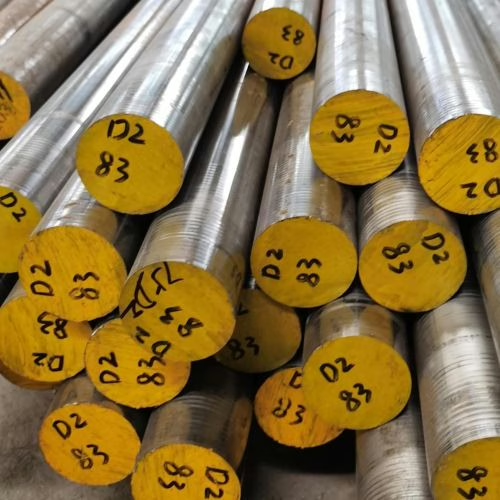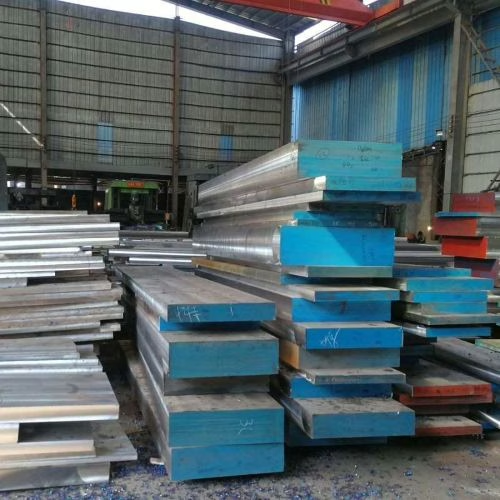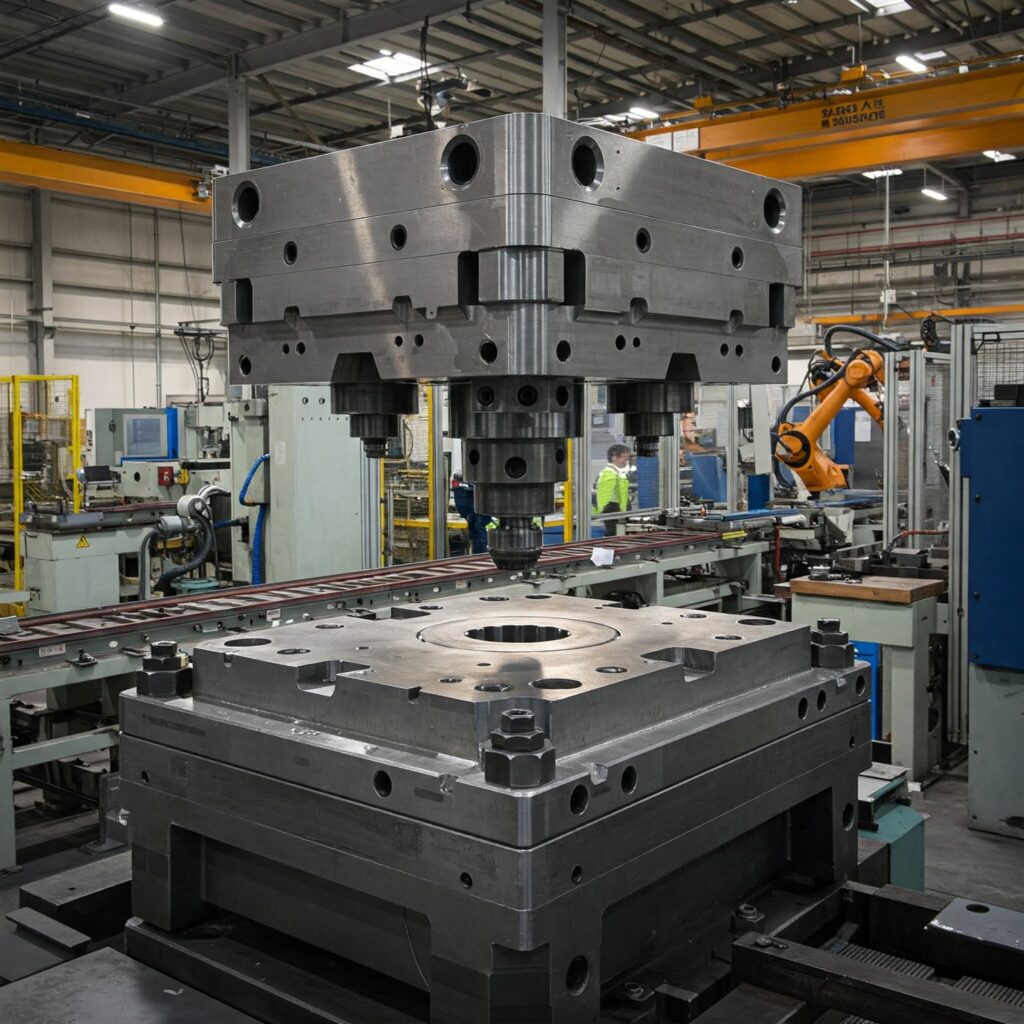Estimated reading time: 7 minutes
Key Takeaways
- D2 steel is a high-carbon, high-chromium cold-work tool steel, while 4140 is a medium-carbon, low-alloy structural steel.
- D2 offers exceptional wear resistance and high hardness (60-62 HRC), yet has limited toughness compared to 4140.
- 4140 steel provides a good balance of strength and toughness, making it suitable for parts under dynamic loads.
- Key applications include D2 for cutting tools and dies, and 4140 for automotive components and drive shafts.
- Choose D2 for wear resistance and dimensional stability; opt for 4140 for strength and toughness.
Table of contents
D2 steel Vs. 4140: D2 tool steel and 4140 steel are both important ferrous alloys, but they belong to different classifications and are designed for distinct applications, exhibiting unique properties and requiring specific heat treatments.
D2 steel is a high-carbon, high-chromium cold-work tool steel. It belongs to the D-series tool steels, which are specifically designed for manufacturing tools, dies, and punches used under demanding conditions for cutting, forming, or machining other materials. Primarily employed for cold work applications, D2 steel typically operates below 200°C, often at room temperature. Among all high-carbon, high-chromium tool steels, D2 stands as a highly significant and representative grade.
AISI 4140 steel is a medium-carbon, low-alloy structural steel, also known as construction steel. Its most significant value lies in the balance between strength and toughness. It is a chromium-molybdenum (Cr-Mo) steel, often grouped with other ultra-high-strength steels such as 4130 and 4340. Although 4140 is highly popular in manufacturing and tooling, it is not classified as tool steel. It is typically supplied in forms such as bars and plates, and achieves specific mechanical properties through heat treatment, making it well-suited for manufacturing high-strength shaft components. It is essential to note that this type of low-alloy steel is not suitable for withstanding high temperatures.


Composition
The properties of D2 steel are determined by its high carbon and high chromium content. The substantial presence of these two elements results in the formation of a large quantity of extremely hard chromium-rich carbides within the steel. 4140 steel, on the other hand, is a medium-carbon alloy steel. Its primary alloying elements are chromium (Cr) and molybdenum (Mo). Molybdenum is particularly crucial in 4140 steel, as it ensures the development of an ideal, fine microstructure after heat treatment. This microstructure is key to achieving the balance of strength and toughness characteristic of 4140 steel.
| Element | D2 Tool Steel (%) | 4140 Steel (%) |
| Carbon (C) | 1.40 – 1.60 | 0.38 – 0.43 |
| Chromium (Cr) | 11.00 – 13.00 | 0.80 – 1.10 |
| Molybdenum (Mo) | 0.70 – 1.20 | 0.15 – 0.25 |
| Manganese (Mn) | 0.10 – 0.60 | 0.75 – 1.00 |
| Vanadium (V) | 0.50 – 1.10 | – |
| Silicon (Si) | 0.10 – 0.60 | 0.15 – 0.35 |
| Phosphorus (P) | ≤ 0.03 | ≤ 0.035 |
| Sulfur (S) | ≤ 0.03 | ≤ 0.040 |
Mechanical Properties
The primary advantage of D2 lies in its exceptional wear resistance. Its high carbon and high chromium composition forms a large number of hard carbides in the microstructure. D2 exhibits extremely high hardness, typically reaching 60 to 62 HRC (Rockwell hardness). 4140 steel can also achieve high strength and hardness through heat treatment, but its hardness values vary significantly depending on the tempering temperature. While it can attain high surface hardness in specific applications (such as nitriding), this is not its core strength.
Compared to D2, one advantage of 4140 is that it strikes a good balance between strength and toughness, making it well-suited for parts subjected to dynamic loads. D2 exhibits moderate toughness and is relatively brittle, especially when compared to specialized impact-resistant steels. While D2 can be used for long-lasting production tools, its limited toughness often leads to its application as an “insert” embedded within a tougher die body, rather than as a standalone component subjected to significant impact.
In terms of absolute load-bearing capacity, the difference between the two is substantial. 4140 Steel: When properly heat-treated, 4140 achieves exceptionally high strength. Ultimate Tensile Strength (UTS): Up to 1965 MPa; Yield Strength: Up to 1740 MPa. This high-strength characteristic, combined with its resistance to torsion and reverse stresses, makes it ideal for manufacturing components like drive shafts. In its standard tempered state, D2’s strength is substantially lower than that of heat-treated 4140. Ultimate tensile strength (UTS) is approximately 758 MPa; yield strength is approximately 411 MPa. D2’s primary characteristic is wear resistance, notwithstanding extreme structural loads.
- Hardness. D2 steel hardness is 60 to 62 HRC after heat treatment. Although 4140 steel can also achieve high hardness through heat treatment, it is lower than that of D2 steel. Quenched and tempered 4140 can range from 235 HB to 578 HB, depending on the tempering temperature.
- Hardenability. D2 is an air-hardening steel, meaning it can be hardened by cooling in air, which minimizes distortion. 4140 steel has moderate hardenability. While it can be air-hardened in thin sections, it is typically oil-quenched in practice for through-hardening.
- Toughness. D2 steel has poor toughness. However, 4140 steel has improved toughness. Its toughness properties are affected by tempering temperature; for instance, tempering between 230 and 370°C (450 to 700°F) is usually avoided to prevent blue brittleness.
- Wear Resistance. D2 steel has extremely high wear resistance, higher than that of 4140 steel. 4140 Steel can significantly improve its wear resistance through surface hardening treatments such as nitriding or induction hardening.
- Machinability. D2 has poor machinability, with a machinability rating of 45, compared to 1% carbon steel, which is rated at 100. 4140 has good machinability, especially resulfurized versions like SAE 1140.
- Dimensional Stability. D2 steel undergoes minimal deformation during heat treatment. When air quenched, it expands or contracts approximately 0.0005 inches per inch. (0.0005 mm/mm). 4140 Steel’s dimensional stability is generally good, but like all steels, it is subject to distortion during quenching, especially with higher carbon content, which can increase the probability of cracking.
Fabrication and Heat Treatment
D2 is an air-hardening tool steel that achieves high hardness through air cooling, exhibiting minimal dimensional changes and deformation during the heat treatment process. Consequently, D2 is suitable for high-precision mold manufacturing. 4140 steel undergoes heat treatment through quenching and tempering. To achieve high strength, it is typically oil-quenched, followed by tempering within a broad temperature range of 205°C to 705°C, to precisely attain the desired strength and toughness.
D2 steel is tough to machine and grind. Its high carbon content and significant chromium content result in poor machinability. 4140, on the other hand, is much easier to machine. Additionally, grades like SAE 41L40, which incorporate added sulfur (S), are available on the market and offer improved machinability even in hardened conditions.
D2 and 4140 steel are both challenging to weld due to their high carbon content and significant carbide content in their microstructure, making conventional welding methods challenging.
Applications
The selection between D2 and 4140 is guided entirely by the intended function, specifically whether the part needs maximum surface abrasion resistance or maximum bulk strength and toughness.
D2 steel is suitable for applications requiring long-term production, high wear resistance, and dimensional stability. Typical applications include cutting and stamping tools and dies, punching dies and tools, forging operations, and trimming tools.
4140 steel is a versatile engineering steel suitable for components requiring moderate hardenability and good strength and toughness. Major applications include drive shafts, shafts for high-load automotive components, gears in critical applications, and high-load components in automotive engines.
| Steel Grade | Key Application Attributes | Examples of Use |
| D2 Steel | Excellent wear resistance; Long-run capability; Dimensional stability; Cold-work operations. | Shafting, gears, axles, crank shafts, machine parts, highly loaded gearing, cold-headed/cold-forged fasteners, and core material for nitrided components. |
| 4140 Steel | High core strength and toughness; Resistance to dynamic/torsional stresses; Suitable for moderate hardenability needs. | Shafting, gears, axles, crank shafts, machine parts, highly loaded gearing, cold-headed/cold-forged fasteners, core material for nitrided components. |
Summary
Overall, when your primary requirement is exceptional wear resistance and high dimensional stability must be ensured during heat treatment, D2 steel is the professional specialty material. When you need to manufacture heavy-duty mechanical components that prioritize the material’s high core strength, ability to withstand dynamic loads, and overall toughness, 4140 is the superior choice.


